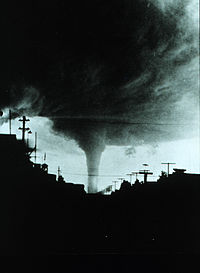在世界的一些地方,特別是在美國,龍捲風可以對旅行者構成威脅。
理解
[編輯]
龍捲風是一個旋轉的極低壓空氣柱,它向內和向上吸收周圍的空氣。它們會產生強風(通常為100-200英里/小時),並且可以將重物舉到空中,並在龍捲風移動時將其也跟著漂移。它們開始是從暴風雲中下降的漏斗狀物,當它們接觸到地面時就變成了「龍捲風」。與颶風不同,龍捲風發展非常迅速,幾乎不會提前發出預警(最多幾分鐘),但它們的壽命也非常短,同樣每次只持續幾分鐘。它們經常成群出現,幾個龍捲風幾乎同時襲擊一個地區。
與氣旋(颶風或颱風)相比,龍捲風更加集中,密度也要大得多。雖然颶風的直徑通常至少跨越幾十英里,甚至上百英里,但龍捲風通常只有一英里也是很罕見的。
據報道,美國每年大約有1000場龍捲風,但是只有其中的一小部分著落並襲擊建築物。此外,只有不到30%的龍捲風是相當強大的(EF2+)。大多數死亡情況都發生在一棟房屋或者汽車上。無論設麼時候龍捲風都有可能發生,但主要還是分布在春季和初夏的雷雨天氣里。請記住,作為一個短期的遊客,無論您在何時何地旅行,在錯誤的時間和錯誤的地點出現龍捲風的機率都是很小的,但無論如何,都請您最好準備。

在美國,龍捲風發生最頻繁的地區通常被稱為龍捲風走廊(Tornado Alley):它位於美國的大平原地區,包括德克薩斯州北部、俄克拉荷馬州、堪薩斯州、內布拉斯加州和南達科他州東部。但是,龍捲風可以在包括且不限於以上的地方發展起來,無論是冷爽乾燥的空氣,還是溫暖濕潤的空氣。超強龍捲風通常發生在美國中西部、南部和大西洋中部地區。美國西部也有龍捲風出現,但是活動卻比美國東半部少得多,加拿大和其他國家的發生頻率也不會那麼高。但是在荷蘭,龍捲風的發生率卻很高。
準備
[編輯]儘管龍捲風發展非常迅速,但是它不會毫無預兆的突然襲來。氣象學家可以確定龍捲風發展的合適的條件,美國國家氣象局為此發布了兩種警報(不過這名字非常相似而且容易令人迷惑):
- Tornado Watch - This indicates that conditions are right for tornadoes, but none has been observed. Monitor conditions and listen for further alerts.
- Tornado Warning - A tornado or funnel cloud (a precursor to a tornado's touching down) has been spotted or is indicated by radar. This is when tornado sirens may begin. Seek shelter immediately. When a powerful tornado is headed for a densely populated area, the NWS issues a Tornado Emergency to stress the severity.
Listen
[編輯]
Some local areas have tornado sirens and lights, especially in Tornado Alley and other regions where tornadoes are a seasonal occurrence. If you hear what sounds like an air raid siren, this is probably a tornado siren sounding, and you should seek shelter immediately. Many communities periodically test these systems at a set time, such as at exactly noon on a weekday of the first week of each month, so check the time and the skies (tornadoes do not develop in sunny weather) before panicking. (Most communities will skip these tests if the weather is stormy, to avoid causing undue alarm.)
Heavy rain and hail can hide a tornado from view. This is especially likely in the more humid regions of the southern and eastern US. Tornadoes will also be very difficult to see at nighttime, unless backlit by frequent lightning. The roar of a tornado (similar to a freight train or a jet aircraft taking off) may be the only sign that one is approaching.
Watch
[編輯]There are some specific signs that a tornado is developing or likely:
- Debris - If you see a cloud of debris being swept into the air in the distance, that could mark the position of a tornado even if you don't see the funnel cloud.
- Green Clouds - Green clouds are normally seen when there is a large amount of ice in the clouds. This is an indication of hail and could be a warning that a tornado is likely.
- Hail - Hail will sometimes occur. The larger the hail the more likely that there may be a tornado associated with the storm.
- Rotation - If you see rotation in the clouds (not just a swirl of wind near ground level, which is an entirely different phenomenon), that may indicate the presence of a tornado or the possibility of a tornado developing.
Day or night, A loud continuous roar or rumble which doesn't fade in a few seconds like thunder or a train could indicate a tornado.
保持安全
[編輯]| 警告:不要在橋下,尤其是地下通道或天橋下躲避龍捲風!由於橋下漏出的飛屑,人們在這次行動中喪生或者嚴重受傷。龍捲風在橋下趨向於更強,這表明,對於避開龍捲風來說,橋根本不是個好主意。 | |
如果龍捲風來臨,請不要把自己當成是一個揮舞著相機的遊客。不要試圖通過拍攝照片來記錄您的大冒險。不要試圖取回你的行李。只要立即確保自己安全即可。
返回室內!
[編輯]最安全的地方是為了龍捲風的安全而專門建造的避難所或安全屋。在龍捲風地區,這些地區經常出現在農村家庭和活動房屋公園內或附近。最重要的是不要驚慌。保持冷靜,找到可以快速到達的最安全的區域。
House
[編輯]如果您處於室內,請遠離窗戶(窗戶可能會破碎),然後轉到最低的樓層。如果有地下室,那麼就進入地下室,否則就鑽到長凳或桌子等比較低的地方。如果沒有地下室,就去中間沒有窗戶的房間,例如壁櫥或浴室。如果在浴室,請躺在浴缸中。蹲下來,如果你有一些墊子,比如床墊,可以保護你不受飛來飛去的碎片的傷害,那就把墊子蓋在身上。不要浪費時間,試圖打開窗戶以防止窗戶被打破,這樣可以更好地利用時間到達避難所。
Tall building
[編輯]Go to the lowest floor or center of the building away from windows and close to an interior wall. Crouch down and cover your head. Do not get in the elevator; you'll be trapped if the electricity goes out, and there's always a chance that the lift mechanism will give out if the roof is damaged. If you're not too high, use internal stairways to reach the ground floor or basement. Stairwells are probably one of the safer places to seek shelter in such circumstances anyway (i.e. no windows, sturdy construction).
Get out!
[編輯]
The least safe place to be is inside something the tornado can pick up; you're actually better off outside.
Mobile home
[編輯]If you are in a mobile home and there's a tornado warning, you should seek out the nearest storm shelter or protected building. People morbidly joke that mobile homes and trailers must somehow attract tornadoes because they are so often shown on TV as twister disaster areas; the serious truth is that their vulnerability is why they make for the most sensational news clips. Studies have shown that a mobile home is the worst place you can be during a tornado; the broad sides of the structure are like a sail in the wind, and there's nothing to hold them in place. It may sound counterintuitive, but you should leave the mobile home and get in a ditch, culvert, or drain pipe, low to the ground. If you are staying in a mobile home and trailer park ask management if there is a tornado shelter close by. These may be cellars or sturdy buildings.
Car
[編輯]If you are in your automobile and you see a tornado coming, don't try to out-run it; tornadoes can easily outrun a car driving into a 100-mph headwind. Your safest option is to leave the car and get in a sturdy building. If that is not available, get out of the car and get in a low area such as a culvert, drain pipe or ditch. If you are staying in your car, attempt to drive at right angles to the tornado to get out of its path. If the tornado does not appear to be moving left or right, chances are it is coming straight for you. A car is probably safer than a mobile home (less wind-catching surface to drag it into the air), but it's still safer to get out and hunker down low. The best option is to find a ditch to lie flat in, and cover up.
在龍捲風之後
[編輯]當心尖銳的物體和掉落的電源線。不要站在電源線朝下的水中。遠離受損嚴重的房屋和建築物,因為那裡可能會有倒塌的危險。請勿使用打火機和火柴,因為可能有氣體洩漏的危險。保持鎮靜,等待當地緊急救援人員的指示。

